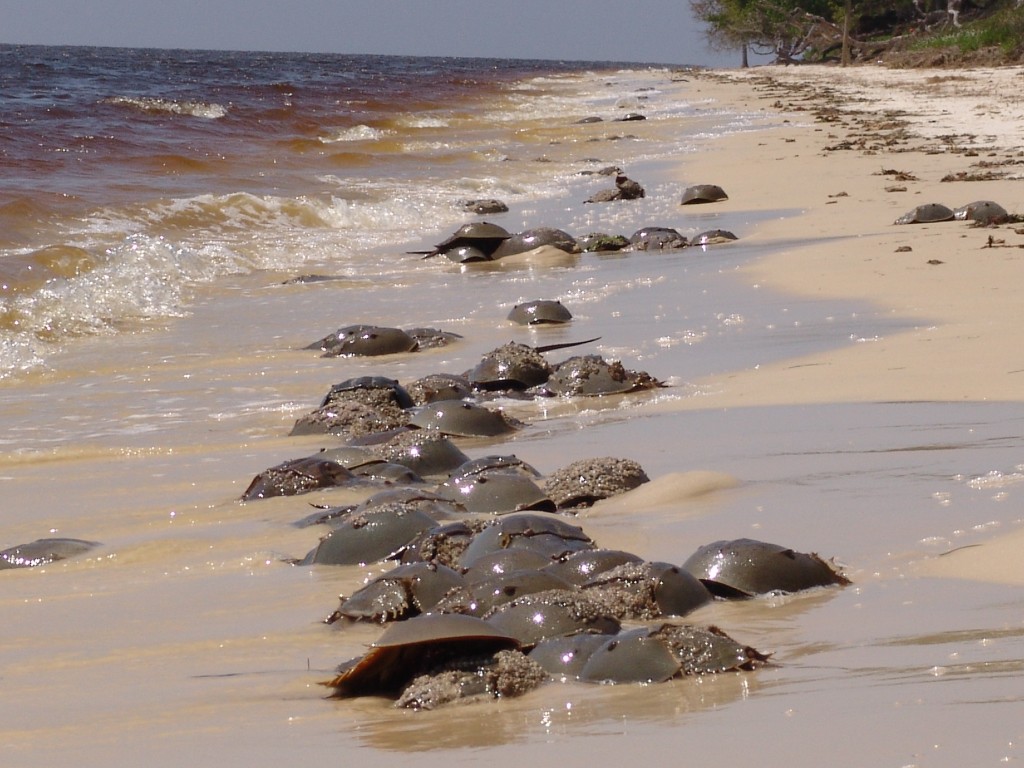
My Current Research
Reproductive Behavior of Horseshoe Crabs Since 1989 I have been studying the behavior, natural history and population biology of the horseshoe crab, Limulus polyphemus, at Seahorse Key, Florida. In spring, female-male pairs of horseshoe crabs come to the beach at Seahorse Key to mate and lay their eggs. This island is part of the Cedar Keys National Wildlife Refuge and it has proven to be a good location for studying this species. When we started no one had ever studied a marked population of this species, so it was important that we obtain basic information on the life history, frequency of breeding, population recruitment, as well as changes in the behavior and condition of individuals over the years. The main focus of my research is the reproductive behavior of horseshoe crabs. Females nest in a narrow strip of sand in the high intertidal. Why do they engage in this costly behavior? We found no evidence to support the hypothesis that eggs buried in the lower beach were more likely to be consumed by predators or that they were differentially washed away by erosion and wave action. However, eggs in the lower beach were less likely to develop due to reduced oxygen and eggs reburied higher than normal were more likely to desiccate. These results mean that females are choosing nest sites that maximize the development of their eggs. Male horseshoe crabs show two nesting tactics: some attach to females as they are coming to shore whereas other males come ashore and crowd around the nesting couples. Paternity analyses, conducted in collaboration with Wayne Potts, revealed that these satellite males were fertilizing a large proportion of the eggs that the female lays which means that they are engaging in sperm competition with the attached male and with other satellites. We have found that attached and unattached males do not differ in size but they do differ in condition and age: attached males are, on average, younger and in better condition than satellite males. We hypothesize that males change from attaching behavior to satellite as they grow older. Satellites are attracted to some (“polyandrous”) couples while ignoring others (“monandrous”). This means that polyandrous females have multiple male paternity of their offspring whereas monandrous females have single male paternity. Under natural conditions, all eggs of both monandrous and polyandrous females are fertilized. Further, experimental removals of satellites have demonstrated that they are costly in terms of the time it takes for females to lay their eggs. So why would females attract satellites if they are costly and all their eggs can be fertilized without satellites?
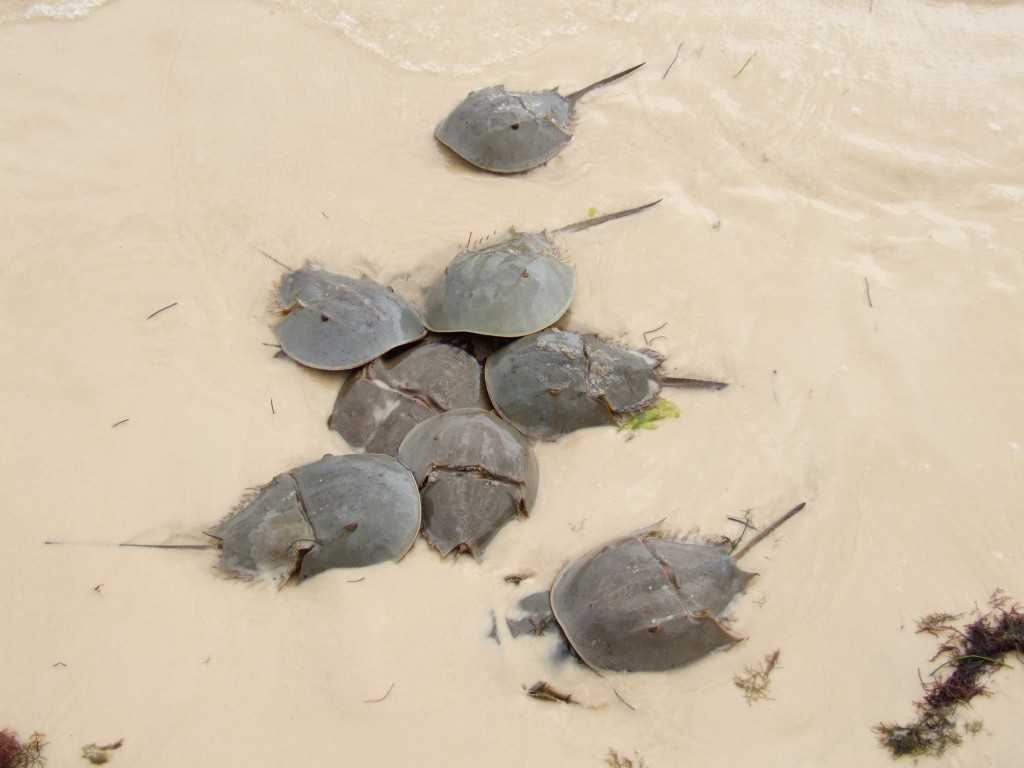
Together with my Post-doctoral Fellow, Sheri Johnson, using in vitro fertilization techniques, we have demonstrated that monandrous females have greater fertilization success with their attached males than do polyandrous females. This suggests that females become polyandrous when their attached male is in poor condition or incompatible. During the past two years, post-doctoral fellow Mary Hart and I have been investigating mate choice in horseshoe crabs. When females differ in their success with different males, one would predict that they should prefer some males over others. The study of male and female alternative strategies in horseshoe crabs provides new insight into the evolution of decision-making processes in animals and how flexible, condition-dependent phenotypes evolve and are maintained in populations. Limulus provides an excellent opportunity for such a study because of the ease with which adults can be observed and manipulated in the field. Their ancient taxonomic origin and independent evolutionary history make them particularly valuable comparative material. The vast amount that is known about some aspects of their reproductive physiology, immunology and development make them valuable subjects for integrative research.
Cohen, J. A. and H. J. Brockmann. 1983. Breeding activity and mate selection in the horseshoe crab, Limulus polyphemus. Bulletin Marine Science, 33: 274-281.
Brockmann, H. J. 1990. Mating behavior of horseshoe crabs, Limulus polyphemus. Behaviour 114:206-220.
Brockmann, H.J. and D. Penn. 1992. Male mating tactics in horseshoe crabs, Limulus polyphemus. Animal Behaviour 44:653-665.
Brockmann, H.J., T. Coleson and W. Potts. 1994. Sperm competition in horseshoe crabs (Limulus polyphemus). Behavioral Ecology and Sociobiology 35: 153-160.
Penn, D. and H. J. Brockmann. 1994. Nest-site selection in the horseshoe crab, Limulus polyphemus. Biological Bulletin 187: 373-384.
Penn, D. and H. J. Brockmann. 1995. Age-biased stranding and righting in horseshoe crabs (Limulus polyphemus). Animal Behaviour 49: 1531-1539.
Brockmann, H. J. 1996. Satellite male groups in horseshoe crabs. Limulus polyphemus. Ethology 102: 1-21.
Brockmann, H.J., C. Nguyen and W. Potts. 2000. Paternity in horseshoe crabs when spawning in multiple male groups. Animal Behaviour 60:837-849.
Hassler, C. and H.J. Brockmann. 2001. Evidence for use of chemical cues by male horseshoe crabs when locating nesting females (Limulus polyphemus). Journal of Chemical Ecology. 27: 2319-2335.
Brockmann, H.J. 2002. An experimental approach to altering mating tactics in male horseshoe crabs (Limulus polyphemus). Behavioral Ecology 13:232-238.
Brockmann, H.J. 2003. Nesting behavior, a shoreline phenomenon. IN The American Horseshoe Crab. Ed. By C. Shuster, R. Barlow and J. Brockmann. Harvard University Press. pp. 33-49.
Brockmann, H.J. 2003. Mating behavior of male horseshoe crabs. IN The American Horseshoe Crab. Ed. By C. Shuster, R. Barlow and J. Brockmann. Harvard University Press. pp. 50-82.
King, T.L., M.S. Eackles, A.P. Spidle and H.J. Brockmann. 2005. Regional differentiation and sex-biased dispersal among populations of horseshoe crabs (Limulus polyphemus). Transactions of the American Fisheries Society 134:441-465.
Duffy, E.E., D. Penn, M.L. Botton, H. J. Brockmannn and R.E. Loveland. 2006. Eye and clasper damage influence male mating tactics in the horseshoe crab, Limulus polyphemus. Journal of Ethology 24: 67-74.
Schwab, R., H.J. Brockmann. 2007. The role of visual and chemical cues in the mating decisions of satellite male horseshoe crabs (Limulus polyphemus). Animal Behaviour 74:837-846.
Brockmann, H.J. and M.D. Smith. Reproductive competition and sexual selection in horseshoe crabs. IN Biology and Conservation of Horseshoe Crabs, Ed. by John Tanacredi, Mark Botton, and David Smith, Springer. pp. 199-221.
Zaldívar-Rae, J., R.E. Sapién-Silva, M. Rosales-Raya, and H. J. Brockmann. 2009. American horseshoe crabs, Limulus polyphemus, in Mexico : open possibilities. IN: Biology and Conservation of Horseshoe Crabs. J. Tanacredi, M. Botton, and D. Smith (eds.). Springer Science. Pp. 97-113.
Johnson, S.L. and H.J. Brockmann. 2010. Costs of multiple mates: an experimental study in horseshoe crabs Animal Behaviour 80: 773-782. This study is also the subject of a featured article in Animal Behaviour 80:771-772.
Saunders, K. and H.J. Brockmann, W. Watson and S.J. Jury. 2010. Male horseshoe crabs, Limulus polyphemus, use multiple sensory cues to locate mates. Current Zoology 56:485-498.
Johnson, S.L. and H.J. Brockmann. 2012. Alternative reproductive tactics in female horseshoe crabs. Behavioral Ecology 23: 999-1008.
Sasson, D.A., S.L. Johnson and H.J. Brockmann. 2012. The role of age on sperm traits in the American horseshoe crab, Limulus polyphemus Animal Behaviour 84: 975–981.
Smith, M.D., H.E. Schrank and H.J. Brockmann. 2013. Measuring the costs of alternative reproductive tactics in horseshoe crabs, Limulus polyphemus. Animal Behaviour 85: 165-173. 10.1016/j.anbehav.2012.10.021.
Johnson, S.L. and H.J. Brockmann. 2013. Parental effects on early development: testing for indirect benefits of polyandry. Behavioral Ecology 24: 1218-1228. DOI: 10.1093/beheco/art056
Nossa, C., P. Havlak, J-X Yue, K. Vincent, J. Lv, N. Lee, H.J. Brockmann and N. H. Putnam. 2014. Joint assembly and genetic mapping of the Atlantic horseshoe crab genome reveals ancient whole genome duplication. accepted GigaScience 3:1-21. doi:10.1186/2047-217X-3-9
Smith, M.D. and H.J. Brockmann. 2014. The evolution and maintenance of sexual size dimorphism in horseshoe crabs: an evaluation of six functional hypotheses. Animal Behaviour 96:127-139.
Vasquez, M.C., S.L. Johnson, H.J. Brockmann and D. Julian. 2014. Nest site selection minimizes environmental stressor exposure in the American horseshoe crab, Limulus polyphemus. Journal of Experimental Marine Biology and Ecology 463: 105-114. doi: 10.1016/j.jembe.2014.10.028
Brockmann, H.J., S.L. Johnson, M.D. Smith and D. Sasson. 2015. Mating tactics of the American Horseshoe crab. IN R.H. Carmichael, Mark L. Botton, P.K.S. Shin and S.G. Cheung, editors. Changing Global Perspectives on Biology, Conservation and Management of Horseshoe Crabs. Ed. by. Springer Scientific (in press)
King, T., M. Eackles, A.W. Aunins, H.J. Brockmann, E.M. Hallerman and B.B.Brown. 2015. Conservation genetics of the horseshoe crab (Limulus polyphemus): allelic diversity, zones of genetic discontinuity, and regional differentiation. IN R.H. Carmichael, Mark L. Botton, P.K.S. Shin and S.G. Cheung, editors. Changing Global Perspectives on Biology, Conservation and Management of Horseshoe Crabs. Ed. by. Springer Scientific (in press)
Sasson, D., Johnson, S.L. and H.J. Brockmann. 2015. Sperm traits in a system with condition-dependent alternative reproductive tactics. Behavioral Ecology and Sociobiology (in press)
Vasquez, M.C., A. Murillo, H.J. Brockmann and D. Julian. 2015. Multiple stressor interactions influence embryo development rate in the American horseshoe crab, Limulus polyphemus. Journal of Experimental Biology. (in press)
Natural History and Population Biology of Florida Horseshoe Crabs
We have recently found that there are five genetically distinct populations of horseshoe crabs in Florida. Only two of these populations have been studied in any detail, our population on the west coast at Seahorse Key and a population on the east coast, in Indian River Lagoon, which has been studied by Gretchen Ehlinger. For all the other populations we do not know the extent of the populations, their status or their reproductive behavior. I am working with various groups to survey horseshoe crabs in Florida to gather information on Florida horseshoe crabs and how they differ from the better studied populations to the north.
Brockmann, H.J. and S.L. Johnson. 2011. A long-term study of spawning activity in a Florida Gulf coast population of horseshoe crabs (Limulus polyphemus). Estuaries and Coasts. 34: 1049-1067. doi: 10.1007/s12237-011-9419-1
Brockmann, H.J., T. Black and Tim L. King. 2015. Florida horseshoe crabs: Populations, genetics and the marine life harvest. IN R.H. Carmichael, Mark L. Botton, P.K.S. Shin and S.G. Cheung, editors. Changing Global Perspectives on Biology, Conservation and Management of Horseshoe Crabs. Ed. by. Springer Scientific (in press) King, T., M. Eackles, A.W. Aunins, H.J. Brockmann, E.M. Hallerman and B.B.Brown. 2015.
Conservation genetics of the horseshoe crab (Limulus polyphemus): allelic diversity, zones of genetic discontinuity, and regional differentiation. IN R.H. Carmichael, Mark L. Botton, P.K.S. Shin and S.G. Cheung, editors. Changing Global Perspectives on Biology, Conservation and Management of Horseshoe Crabs. Ed. by. Springer Scientific (in press)
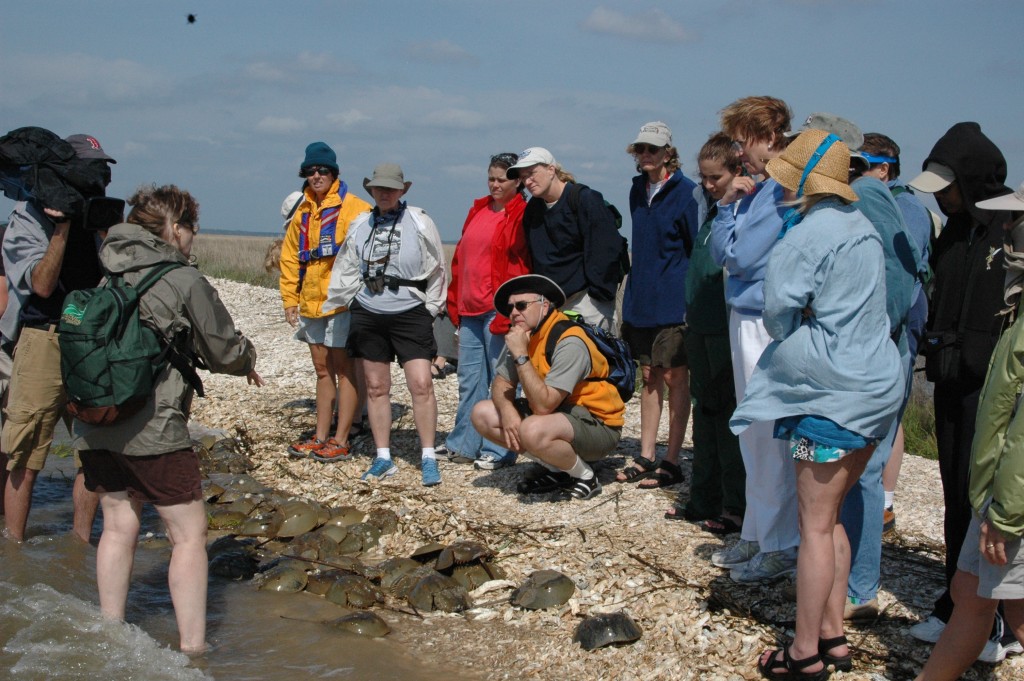
Broader Impacts of our Research
Horseshoe crabs are a major conservation issue in the Delaware Bay and in other areas along the Atlantic coast. The issue is that migratory birds feed on horseshoe crab eggs and one species in particular, the red knot, depends on this source of food during its spring migration. Horseshoe crabs are harvested for bait and in recent years so many have been taken that the horseshoe crab – migratory bird phenomenon of DE Bay has been threatened. In addition, the blood of horseshoe crabs is a crucial component in a very important medical test, LAL. This complex issue is presented in a curriculum on horseshoe crabs and discussed in annual workshops for teachers called “Green Eggs and Sand“. I am pleased to be participating in this extremely interesting program. For further information on horseshoe crabs see: Department of Natural Resources, Maryland: http://dnr.maryland.gov/education/are/horseshoecrab/index.asp University of Delaware, College of Marine Studies: http://www.ocean.udel.edu/horseshoecrab/ New Jersey Audubon Society: http://www.njaudubon.org/Conservation/HScrabalert.html Marine Biology Lab, Woods Hole, MA: http://www.mbl.edu/animals/Limulus/ Florida Marine Research Institute: http://www.floridamarine.org/horseshoe_crab/ ERDG (an excellent general site): http://www.horseshoecrab.org/
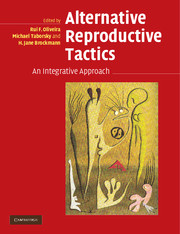
The Evolution of Alternative Tactics Alternative mating and nesting tactics and sex ratios are part of a much broader problem in evolution, the origin and maintenance of discrete, alternative phenotypes. I am interested in understanding the evolutionary factors that favor the appearance of discrete alternative behavior patterns in populations (in one sex at one time), the factors that influence the frequencies of the alternatives, the factors that influence the degree of flexibility and the underlying mechanisms controlling the alternative phenotypes.
2001. Brockmann, H.J. The evolution of alternative strategies and tactics. Advances in the Study of Behavior. 30:1-51.
1992. Brockmann, H.J. and D. Penn. Male mating tactics in horseshoe crabs, Limulus polyphemus. Animal Behaviour 44:653-665.
2008. Oliveira, R., M. Taborsky and H.J.Brockmann (eds.) Alternative Reproductive Tactics – An Integrative Approach. Cambridge University Press.
2008. Brockmann, H.J. and M. Taborsky. Alternative reproductive tactics and the evolution of alternative allocation phenotypes. IN: Oliveira, R., M. Taborsky and H.J.Brockmann (eds.) Alternative Reproductive Tactics – An Integrative Approach. Cambridge University Press, pp. 23-51.
2008. Brockmann, H.J. Alternative reproductive tactics in insects. IN: Oliveira, R., M. Taborsky and H.J.Brockmann (eds.) Alternative Reproductive Tactics – An Integrative Approach. Cambridge University Press, pp. 177-223
2010. Taborsky, M. and H.J. Brockmann. Alternative reproductive tactics and life history phenotypes. IN: Animal Behaviour: Evolution and Mechanisms. P. Kappeler (ed.). Springer Verlag Publ. pp. 537-586. 2012.
Johnson, S.L. and H.J. Brockmann. Alternative reproductive tactics in female horseshoe crabs. Behavioral Ecology 23: 999-1008.
Past Reseach
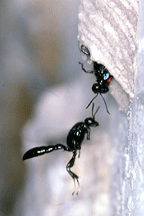 |
| A male pipe-organ mud-daubing wasp guards the entrance to a nest that a female is provisioning. He is chasing away an intruding male. |
Mating and Nesting Tactics of Wasps Prior to studying horseshoe crabs, I spent 10 years observing the mating and nesting behavior of a solitary, mud-daubing wasp, Trypoxylon politum. This was a detailed field study on the behavior of males who guard the nests that females build, a very unusual pattern for male wasps. Females have at least five different ways of nesting, including nest-sharing and brood parasitism, and I was interested in understanding how such diversity is maintained in the population. The wasps also have a strongly male-biased sex ratio in the spring generation and a 50:50 sex ratio in the summer generation. I studied the maintenance of this unusual pattern, which seems to be related to their life-history (partial bivoltinism) and this resulted in my studying their highly variable patterns of emergence and diapause. My study of mud-daubing wasps related more broadly to issues about the evolution of alternative mating and nesting tactics, to evolutionary conflicts of interest between males and females and to the evolution of social behavior.
1984 Brockmann, H. J. The evolution of insect sociality. In J. Krebs and N. Davies (eds.) Behavioral Ecology. Sinauer Associates, Second Edition, pp. 340-361.
1987 Seger, J. and H. J. Brockmann. What is bet-hedging? In P. Harvey and L. Partridge (eds.) Oxford Surveys in Evolutionary Biology. Oxford Univ. Press, 4:182-211.
1988 Brockmann, H. J. Father of the brood (Conflict and cooperation in a mud-daubing wasp). Natural History Magazine. 97(7):32-37. 1989 Brockmann, H. J. and A. Grafen. Mate conflict and male behavior in a solitary wasp, Trypoxylon politum. Animal Behaviour 37:232-255.
1992 Brockmann, H. J. and A. Grafen. Sex ratios and life-history patterns of a solitary wasp. Behavioral Ecology and Sociobiology 30:7-27.
1992 Brockmann, H. J. Male behavior, courtship and nesting of the solitary wasp, Trypoxylon monteverdeae. Journal of the Kansas Entomological Society 65(1):66-84.
1993 Brockmann, H. J. Parasitizing conspecifics: comparison between Hymenoptera and birds. Trends in Ecology and Evolution. 8:2-3.
1997 Brockmann, H. J. Cooperative Breeding in Wasps and Vertebrates: the Role of Ecological Constraints. IN Evolution of Social Behaviour in Insects and Arachnids, J. Choe and B. Crespi (eds.). Cornell University Press. pp. 348-371.
2004 Brockmann, H.J. Variable Life-History Patterns in the Pipe-Organ Mud-daubing Wasp, Trypoxylon politum (Hymenoptera: Sphecidae). Journal of the Kansas Entomological Society (invited memorial volume for Howard E. Evans) 77: 503-527.
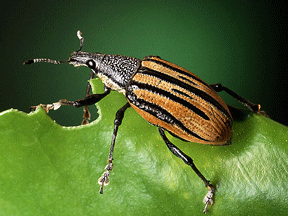 |
| Female Diaprepes root weevil. |
Sexual Selection in a Beetle. The root weevil, Diaprepes abbreviatus, is a wonderful species to study; it is large, easy to observe, adapts well to the laboratory and it mates all the time. The animals are easy to observe in the field where they sometimes occur in large aggregations. Since this species is an important agricultural pest of citrus in Florida, a considerable amount is known about various aspects of its life history and ecology, but little is known about behavior. An Israeli colleague working at the USDA Lab, Ally Harrari, and I conducted a study on the diverse mating behavior of this species. We examined why females mate multiply, sperm competition and mounting by females of other females and males of other males. Laura Sirot (Ph.D. 2004) continued this research and took the study considerably further. Laura examined one of the most vexing problems in sexual selection, the role of cryptic female choice. Cryptic choice refers to choice-like processes that occur after mating that result in non-random fertilization. This process is suspected in a number of species but the evidence is slim because it is so difficult to separate the role of female choice for male traits from differences in the effectiveness of different males in fertilizing eggs (e.g. through sperm competition). She has also examined the role of copulatory courtship (courtship during their long matings such as tapping the female with the antennae) in influencing fertilization success.
1999. Harari, A. R. and H. J. Brockmann. Male beetles attracted by females mounting. Nature 401:763.
2000. Harrari, A. and H.J. Brockmann. Intrasexual mounting in the beetle Diaprepes abbreviatus. Proceeding of the Royal Society of London B 267: 2071-2079.
2003. Harari A.R., P.J. Landolt , C.W. O’Brien, H.J. Brockmann. Prolonged guarding behavior and sperm competition in the weevil Diaprepes abbreviatus (L.) (Coleoptera: Curculionidae). Behavioral Ecology 14: 89-96. 2007.
Sirot L.K., H.J. Brockmann and S.L. Lapointe. 2007. Male post-copulatory reproductive success in the beetle, Diaprepes abbreviatus. Animal Behaviour 74:143-152.
(a) |
(b)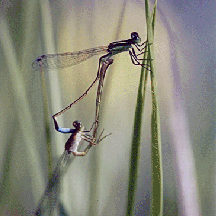 |
| (a) Mating damselflies showing the female color polymorphism, the male mimic or andromorph and (b) the gynomorph. | |
Alternative Female Tactics in a Damselfly Laura Sirot (M.S. 1999) studied a female-limited color polymorphism in a damselfly, another case of alternative strategies, but this one is controlled by a genetic polymorphism. Female damselflies of Ischnura ramburi come in two color forms, one that looks different from the males (gynomorph) and one that mimics male color and pattern (andromorph). The hypothesis to explain male mimicry was that females can avoid the very long and costly mating characteristic of this species by looking like males. In an extremely ambitious set of laboratory experiments, Laura demonstrated that mating is expensive for females, particularly for andromorphic females, when they are in a caged situation where males recognize them as females, i.e. when their mimicry is broken. Intensive field observations, experiments and censuses in a number of habitats demonstrated that andromorphic and gynomorphic females mate the same number of times but they behave differently when they encounter males. We think that the two color morphs are equally successful but use quite different approaches to maximizing success.
- Sirot, L. and H.J. Brockmann. Costs of sexual interactions to females in Rambur’s forktail damselfly, Ischnura ramburi (Zygoptera: Coenagrionidae). Animal Behaviour. 61:415-424.
- Sirot, LK and HJ Brockmann, C. Marinis and G. Muschett. Maintenance of a female-limited polymorphism in Ischnura ramburi (Zygoptera: Coenagrionidae): evaluation of hypotheses and new insights. Animal Behaviour 66: 763-775.
(a) |
(b) |
| Gryllus rubens has two forms. (a) Long-winged morph and (b) short-winged. The pictures are from the Singing Insects of North America http://buzz.ifas.ufl.edu/crickets.htm | |
Sexual Selection and Alternative Morphs in Crickets On a warm summer evening, you can often hear crickets singing in an effort to attract females. But in the field cricket, Gryllus rubens, all this singing also attracts a fly that lays her larvae (her eggs hatch inside her body) on the singing male. These larvae burrow in and kill the male within seven days. In Florida where Manuel Vélez (Ph.D. 2004) conducted this study, flies are around only during the fall but the crickets sing all year. This means that spring males can sing whenever and as much as they want but autumn males are constantly faced with death whenever they sing for females. We found that fewer autumn males sing (they search for females without singing) and they are less likely to sing at dusk when flies are most active, but if an autumn male does sing, he sings more than spring males. This is because singing is more effective at attracting females in the autumn than in the spring. Females that approach conspicuous males may also be vulnerable to predation. This means that selection for reduced male conspicuousness in the presence of these parasites may also be due to selection on females to alter their preferences in the presence of parasites. Since female crickets are also parasitized by these flies as a result of associating with calling males, we predicted that autumn females should be less attracted to male song than spring females. We tested female response to male calls in a rectangular arena in which male calling song was broadcast from a speaker. Spring females readily approached the speaker but autumn females were less likely to approach and remain in the vicinity of the speaker. These results emphasize the importance of considering how risk affects the evolution of conspicuous male behavior both directly through its effect on the male and indirectly through its effect on female responses to males.
2006. Vélez, M. and H.J. Brockmann. Seasonal variation in selection on male calling song in the field cricket, Gryllus rubens. Animal Behaviour 72:439-448.
2006. Vélez, M. and H.J. Brockmann. Seasonal variation in female phonotaxis to male calling song of the field cricket Gryllus rubens. Ethology 112:1041-1049.